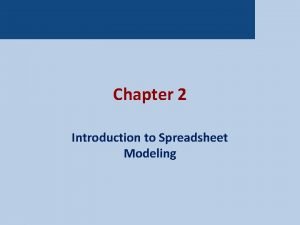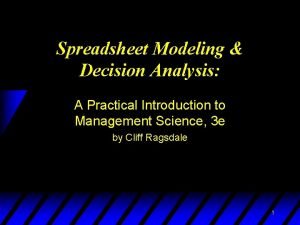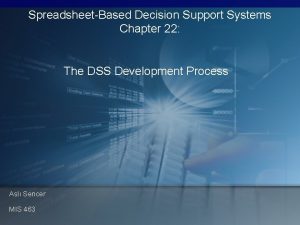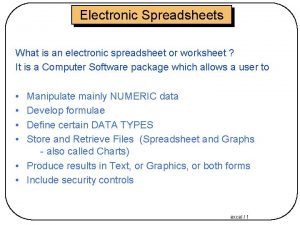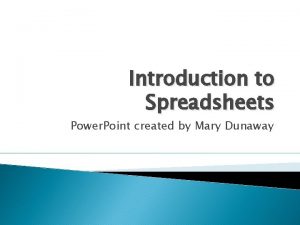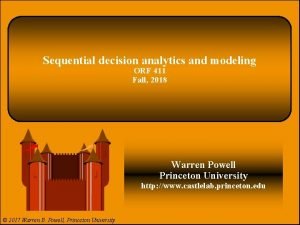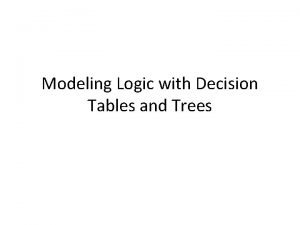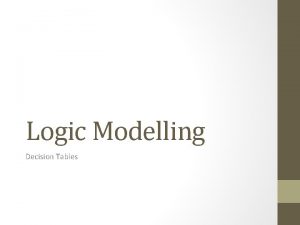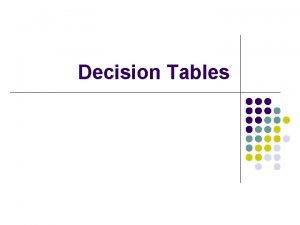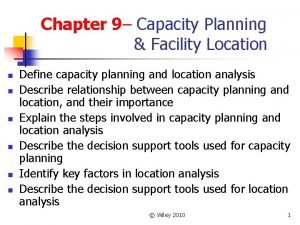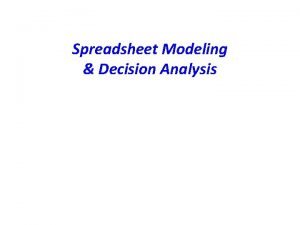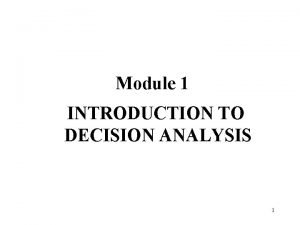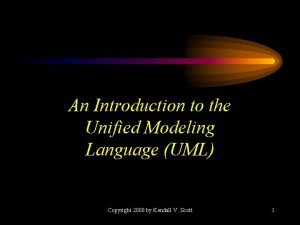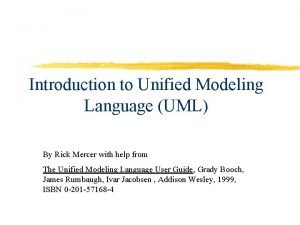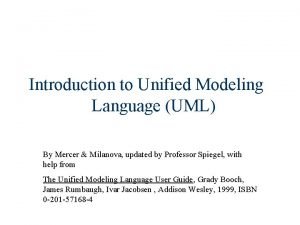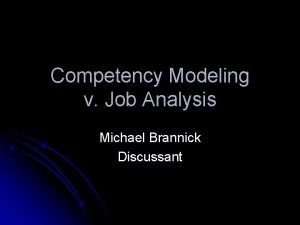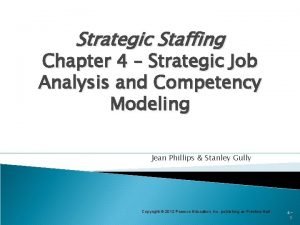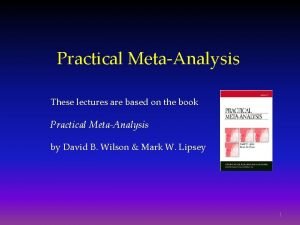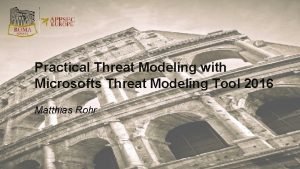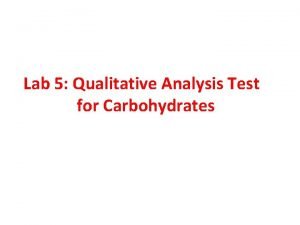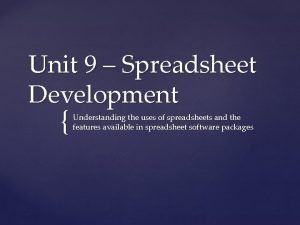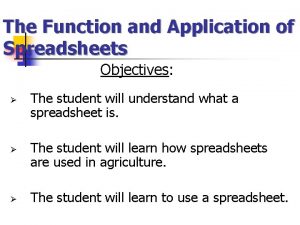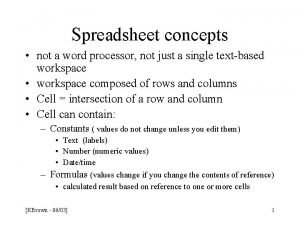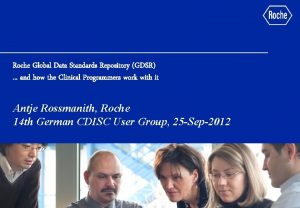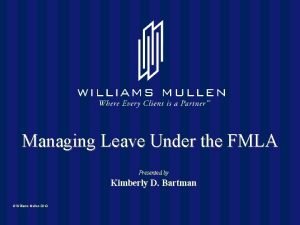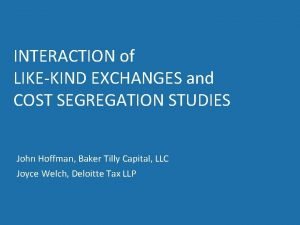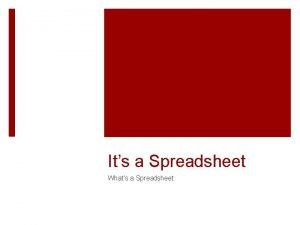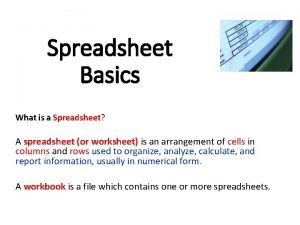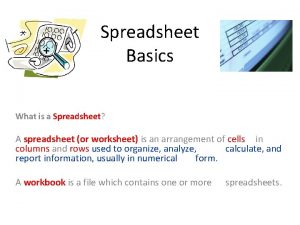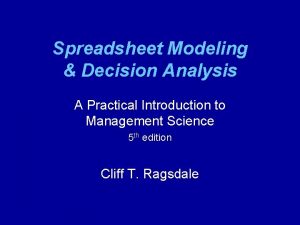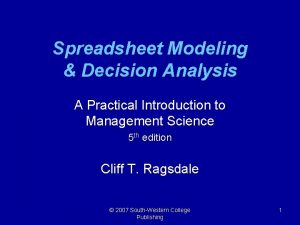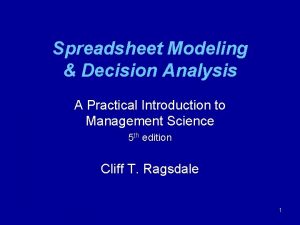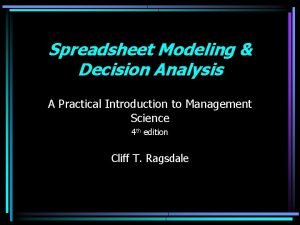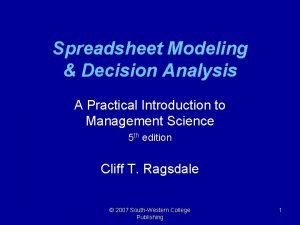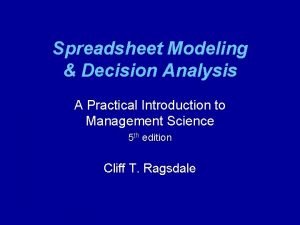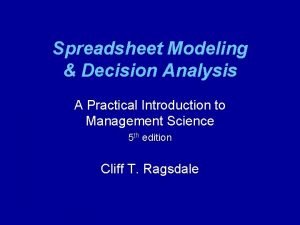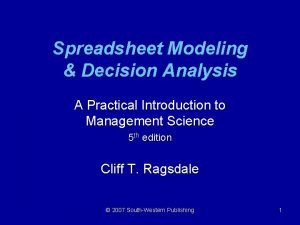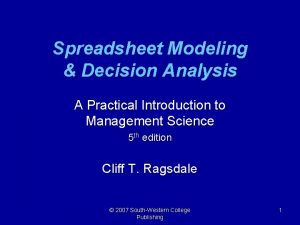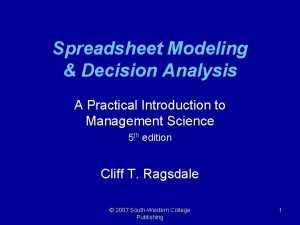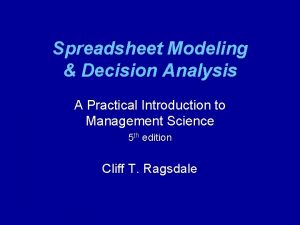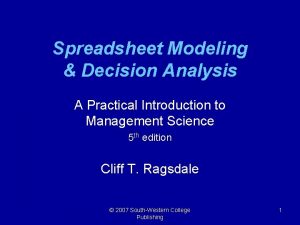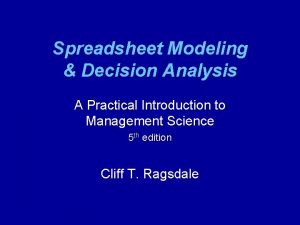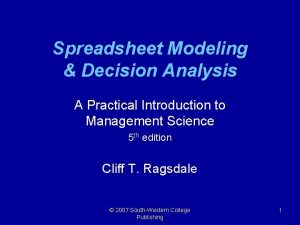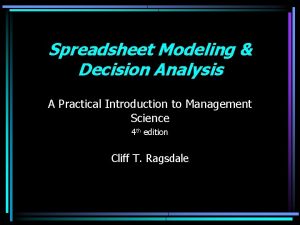Spreadsheet Modeling Decision Analysis A Practical Introduction to












































- Slides: 44

Spreadsheet Modeling & Decision Analysis A Practical Introduction to Management Science 5 th edition Cliff T. Ragsdale © 2007 South-Western College Publishing 1

Chapter 9 Regression Analysis © 2007 South-Western College Publishing 2

Introduction to Regression Analysis § Regression Analysis is used to estimate a function f( ) that describes the relationship between a continuous dependent variable and one or more independent variables. Y = f(X 1, X 2, X 3, …, Xn) + e Note: • f( ) describes systematic variation in the relationship. · e represents the unsystematic variation (or random error) in the relationship. © 2007 South-Western College Publishing 3

An Example § Consider the relationship between advertising (X 1) and sales (Y) for a company. § There probably is a relationship. . . as advertising increases, sales should increase. § But how would we measure and quantify this relationship? See file Fig 9 -1. xls © 2007 South-Western College Publishing 4

A Scatter Plot of the Data Sales (in $1, 000 s) Advertising (in $1, 000 s) © 2007 South-Western College Publishing 5

The Nature of a Statistical Relationship Y Regression Curve Probability distributions for Y at different levels of X © 2007 South-Western College Publishing X 6

A Simple Linear Regression Model § The scatter plot shows a linear relation between advertising and sales. § So the following regression model is suggested by the data, This refers to the true relationship between the entire population of advertising and sales values. § The estimated regression function (based on our sample) will be represented as, © 2007 South-Western College Publishing 7

Determining the Best Fit § Numerical values must be assigned to b 0 and b 1 § The method of “least squares” selects the values that minimize: § If ESS=0 our estimated function fits the data perfectly. § We could solve this problem using Solver. . . © 2007 South-Western College Publishing 8

Using Solver. . . See file Fig 9 -4. xls © 2007 South-Western College Publishing 9

The Estimated Regression Function § The estimated regression function is: © 2007 South-Western College Publishing 10

Using the Regression Tool § Excel also has a built-in tool for performing regression that: – is easier to use – provides a lot more information about the problem See file Fig 9 -1. xls © 2007 South-Western College Publishing 11

The TREND() Function TREND(Y-range, X-value for prediction) where: Y-range is the spreadsheet range containing the dependent Y variable, X-range is the spreadsheet range containing the independent X variable(s), X-value for prediction is a cell (or cells) containing the values for the independent X variable(s) for which we want an estimated value of Y. Note: The TREND( ) function is dynamically updated whenever any inputs to the function change. However, it does not provide the statistical information provided by the regression tool. It is best two use these two different approaches to doing regression in conjunction with one another. © 2007 South-Western College Publishing 12

Evaluating the “Fit” Sales (in $000 s) 600. 0 500. 0 400. 0 300. 0 2 R = 0. 9691 200. 0 100. 0 20 30 40 50 60 70 80 90 100 Advertising (in $000 s) © 2007 South-Western College Publishing 13

The R 2 Statistic § The R 2 statistic indicates how well an estimated regression function fits the data. § 0 < R 2 < 1 § It measures the proportion of the total variation in Y around its mean that is accounted for by the estimated regression equation. § To understand this better, consider the following graph. . . © 2007 South-Western College Publishing 14

Error Decomposition Y Yi (actual value) * Yi - Y ^ Yi - Y i ^ (estimated value) Y i ^ -Y Y i Y ^ Y = b 0 + b 1 X © 2007 South-Western College Publishing X 15

Partition of the Total Sum of Squares or, TSS = ESS + © 2007 South-Western College Publishing RSS 16

Making Predictions § Suppose we want to estimate the average levels of sales expected if $65, 000 is spent on advertising. § Estimated Sales = 36. 342 + 5. 550 * 65 = 397. 092 § So when $65, 000 is spent on advertising, we expect the average sales level to be $397, 092. © 2007 South-Western College Publishing 17

The Standard Error § The standard error measures the scatter in the actual data around the estimate regression line. where k = the number of independent variables § For our example, Se = 20. 421 § This is helpful in making predictions. . . © 2007 South-Western College Publishing 18

An Approximate Prediction Interval § An approximate 95% prediction interval for a new value of Y when X 1=X 1 h is given by where: § Example: If $65, 000 is spent on advertising: 95% lower prediction interval = 397. 092 - 2*20. 421 = 356. 250 95% upper prediction interval = 397. 092 + 2*20. 421 = 437. 934 § If we spend $65, 000 on advertising we are approximately 95% confident actual sales will be between $356, 250 and $437, 934. © 2007 South-Western College Publishing 19

An Exact Prediction Interval § A (1 -a)% prediction interval for a new value of Y when X 1=X 1 h is given by where: © 2007 South-Western College Publishing 20

Example § If $65, 000 is spent on advertising: 95% lower prediction interval = 397. 092 - 2. 306*21. 489 = 347. 556 95% upper prediction interval = 397. 092 + 2. 306*21. 489 = 446. 666 § If we spend $65, 000 on advertising we are 95% confident actual sales will be between $347, 556 and $446, 666. § This interval is only about $20, 000 wider than the approximate one calculated earlier but was much more difficult to create. § The greater accuracy is not always worth the trouble. © 2007 South-Western College Publishing 21

Comparison of Prediction Interval Techniques Sales 575 525 475 Prediction intervals created using standard error Se 425 375 325 Regression Line 275 Prediction intervals created using standard prediction error Sp 225 175 125 25 35 45 55 65 75 Advertising Expenditures © 2007 South-Western College Publishing 85 95 22

Confidence Intervals for the Mean § A (1 -a)% confidence interval for the true mean value of Y when X 1=X 1 h is given by where: © 2007 South-Western College Publishing 23

A Note About Extrapolation § Predictions made using an estimated regression function may have little or no validity for values of the independent variables that are substantially different from those represented in the sample. © 2007 South-Western College Publishing 24

Multiple Regression Analysis § Most regression problems involve more than one independent variable. § If each independent variables varies in a linear manner with Y, the estimated regression function in this case is: § The optimal values for the bi can again be found by minimizing the ESS. § The resulting function fits a hyperplane to our sample data. © 2007 South-Western College Publishing 25

Example Regression Surface for Two Independent Variables Y * * * ** * * * X 2 © 2007 South-Western College Publishing X 1 26

Multiple Regression Example: Real Estate Appraisal § A real estate appraiser wants to develop a model to help predict the fair market values of residential properties. § Three independent variables will be used to estimate the selling price of a house: – total square footage – number of bedrooms – size of the garage § See data in file Fig 9 -17. xls © 2007 South-Western College Publishing 27

Selecting the Model § We want to identify the simplest model that adequately accounts for the systematic variation in the Y variable. § Arbitrarily using all the independent variables may result in overfitting. § A sample reflects characteristics: – representative of the population – specific to the sample § We want to avoid fitting sample specific characteristics -- or overfitting the data. © 2007 South-Western College Publishing 28

Models with One Independent Variable § With simplicity in mind, suppose we fit three simple linear regression functions: § Key regression results are: Variables in the Model R 2 Adjusted R 2 X 1 X 2 X 3 0. 870 0. 759 0. 793 0. 855 0. 731 0. 770 Se Parameter Estimates 10. 299 b 0=9. 503, b 1=56. 394 14. 030 b 0=78. 290, b 2=28. 382 12. 982 b 0=16. 250, b 3=27. 607 § The model using X 1 accounts for 87% of the variation in Y, leaving 13% unaccounted for. © 2007 South-Western College Publishing 29

Important Software Note When using more than one independent variable, all variables for the X-range must be in one contiguous block of cells (that is, in adjacent columns). © 2007 South-Western College Publishing 30

Models with Two Independent Variables § Now suppose we fit the following models with two independent variables: § Key regression results are: Variables in the Model X 1 & X 2 X 1 & X 3 R 2 Adjusted R 2 Se 0. 870 0. 939 0. 877 0. 855 0. 924 0. 847 10. 299 7. 471 10. 609 Parameter Estimates b 0=9. 503, b 1=56. 394 b 0=27. 684, b 1=38. 576 b 2=12. 875 b 0=8. 311, b 1=44. 313 b 3=6. 743 § The model using X 1 and X 2 accounts for 93. 9% of the variation in Y, leaving 6. 1% unaccounted © 2007 South-Western College 31 for. Publishing

The Adjusted R 2 Statistic § As additional independent variables are added to a model: – The R 2 statistic can only increase. – The Adjusted-R 2 statistic can increase or decrease. § The R 2 statistic can be artificially inflated by adding any independent variable to the model. § We can compare adjusted-R 2 values as a heuristic to tell if adding an additional independent variable really helps. © 2007 South-Western College Publishing 32

A Comment On Multicollinearity § It should not be surprising that adding X 3 (# of bedrooms) to the model with X 1 (total square footage) did not significantly improve the model. § Both variables represent the same (or very similar) things -- the size of the house. § These variables are highly correlated (or collinear). § Multicollinearity should be avoided. © 2007 South-Western College Publishing 33

Model with Three Independent Variables § Now suppose we fit the following model with three independent variables: § Key regression results are: Variables in the Model R 2 X 1 & X 2 X 1, X 2 & X 3 0. 870 0. 939 0. 943 Adjusted R 2 Se Parameter Estimates 0. 855 10. 299 b 0=9. 503, b 1=56. 394 0. 924 7. 471 b 0=27. 684, b 1=38. 576, b 2=12. 875 0. 918 7. 762 b 0=26. 440, b 1=30. 803, b 2=12. 567, b 3=4. 576 § The model using X 1 and X 2 appears to be best: – Highest adjusted-R 2 – Lowest Se (most precise prediction intervals) © 2007 South-Western College Publishing 34

Making Predictions § Let’s estimate the avg selling price of a house with 2, 100 square feet and a 2 -car garage: § The estimated average selling price is $134, 444 § A 95% prediction interval for the actual selling price is approximately: 95% lower prediction interval = 134. 444 - 2*7. 471 = $119, 502 95% lower prediction interval = 134. 444 + 2*7. 471 = $149, 386 © 2007 South-Western College Publishing 35

Binary Independent Variables § Other types of non-quantitative factors could independent variables could be included in the analysis using binary variables. § Example: The presence (or absence) of a swimming pool, § Example: Whether the roof is in good, average or poor condition, © 2007 South-Western College Publishing 36

Polynomial Regression § Sometimes the relationship between a dependent and independent variable is not linear. § This graph suggests a quadratic relationship between square footage (X) and selling price (Y). © 2007 South-Western College 37 Publishing

The Regression Model § An appropriate regression function in this case might be, or equivalently, where, © 2007 South-Western College Publishing 38

Implementing the Model See file Fig 9 -25. xls © 2007 South-Western College Publishing 39

Graph of Estimated Quadratic Regression Function © 2007 South-Western College Publishing 40

Fitting a Third Order Polynomial Model § We could also fit a third order polynomial model, or equivalently, where, © 2007 South-Western College Publishing 41

Graph of Estimated Third Order Polynomial Regression Function © 2007 South-Western College Publishing 42

Overfitting § When fitting polynomial models, care must be taken to avoid overfitting. § The adjusted-R 2 statistic can be used for this purpose here also. © 2007 South-Western College Publishing 43

End of Chapter 9 © 2007 South-Western College Publishing 44
 What is a spreadsheet model
What is a spreadsheet model Cliff ragsdale spreadsheet modeling solutions
Cliff ragsdale spreadsheet modeling solutions No decision snap decision responsible decision
No decision snap decision responsible decision Financial management process
Financial management process Developing spreadsheet-based decision support systems
Developing spreadsheet-based decision support systems Role modeling theory
Role modeling theory Relational vs dimensional data modeling
Relational vs dimensional data modeling What is an electronic spreadsheet?
What is an electronic spreadsheet? Introduction to spreadsheet ppt
Introduction to spreadsheet ppt Sequential decision analytics and modeling
Sequential decision analytics and modeling Decision logic table
Decision logic table Jan vanthienen
Jan vanthienen Decision logic table
Decision logic table Explain the decision tree modeling for capacity expansion
Explain the decision tree modeling for capacity expansion Decision tree approach
Decision tree approach Introduction to decision analysis
Introduction to decision analysis Decision tree and decision table examples
Decision tree and decision table examples Introduction to the unified modeling language
Introduction to the unified modeling language Introduction to modeling and simulation
Introduction to modeling and simulation Contoh proses stokastik dalam kehidupan sehari-hari
Contoh proses stokastik dalam kehidupan sehari-hari Introduction to unified modeling language
Introduction to unified modeling language Mercer oneview login
Mercer oneview login Kinicki management a practical introduction
Kinicki management a practical introduction Read management: a practical introduction
Read management: a practical introduction Practical research
Practical research Management: a practical introduction
Management: a practical introduction Management a practical introduction 3e
Management a practical introduction 3e Kinicki: management: a practical introduction 3rd edition
Kinicki: management: a practical introduction 3rd edition Simulation kelton
Simulation kelton Dfd ch5
Dfd ch5 System requirements checklist output example
System requirements checklist output example Job analysis vs competency modeling
Job analysis vs competency modeling Manufacturing systems modeling and analysis
Manufacturing systems modeling and analysis Strategic staffing definition
Strategic staffing definition Practical meta analysis
Practical meta analysis Free threat modeling tools
Free threat modeling tools Fructose is non reducing sugar
Fructose is non reducing sugar Unit 9 spreadsheet development
Unit 9 spreadsheet development Objectives of spreadsheet
Objectives of spreadsheet Qa spreadsheet
Qa spreadsheet Spreadsheet concepts
Spreadsheet concepts Gdsr roche
Gdsr roche Microsoft excel merupakan program aplikasi.... *
Microsoft excel merupakan program aplikasi.... * Fmla rolling calendar tracking spreadsheet
Fmla rolling calendar tracking spreadsheet Cost segregation seminar
Cost segregation seminar
